- A car firebombing incident targeted a senior CFMEU organiser, emphasizing violence in Australia’s construction industry.
- The organiser’s involvement in a major safety dispute raises concerns about retaliation and intimidation tactics.
- Prior threats and graffiti at the organiser’s residence indicate a climate of fear among union officials.
- Authorities are investigating possible connections to underworld influence and internal union conflicts.
- The incident highlights the urgent need for accountability and integrity to protect workers in the construction sector.
- CFMEU officials call for an end to criminal violence, advocating for a safer working environment.
A chilling incident has erupted in the heart of Australia’s construction industry—a car firebombed outside the home of a senior organiser from the Construction, Forestry and Maritime Employees Union (CFMEU). This brazen attack, which occurred around 1 AM in Sydney, highlights the pervasive culture of violence and intimidation that continues to plague the sector.
The targeted vehicle belonged to a union official who has been at the forefront of a crucial safety dispute on a major NSW state government project. Prior to this shocking act, the organiser’s home had already fallen victim to threatening graffiti, shrouding the workplace in fear. In response, CFMEU administrator Mark Irving emphasized a commitment to safety, declaring that no worker should endure such criminal violence.
The incident raises troubling questions about the influence of underworld figures in the construction industry, with authorities considering various theories—including connections to a recent industrial dispute and internal conflicts among union members facing corruption allegations. In fact, police had previously warned Irving of an imminent death threat against him.
This firebombing not only underscores the rampant corruption within the industry but also reflects the ongoing fight for integrity against a backdrop of fear and coercion. The key takeaway? It’s time for accountability in an industry that must be safeguarded for all workers. As investigations unfold, the hope for a safer, more transparent construction environment remains a vital battle.
Shocking Violence in Australia’s Construction Industry: What You Need to Know
Overview of the Incident
A recent alarming incident in Australia’s construction industry has underscored the ongoing struggles against violence and corruption within this sector. A car was firebombed outside the home of a senior official from the Construction, Forestry and Maritime Employees Union (CFMEU), signaling a disturbing trend of intimidation and criminal activity that personnel in this field are confronting daily. This act, taking place in the early hours of the morning in Sydney, points to a much larger issue that threatens the safety and integrity of workers involved in major projects.
Key Developments and Insights
– Persistent Intimidation: Prior to the firebombing, the union official had experienced threatening graffiti at their residence, indicating a prolonged campaign of harassment.
– Union Response: CFMEU’s Mark Irving highlighted the organization’s commitment to worker safety and called for measures against such criminal activities, stressing that no one should have to deal with these threats while performing their jobs.
– Underlying Issues: The nature of the attack points to possible underlying tensions in the sector, including allegations of corruption and the negative influence of organized crime. Authorities are exploring various theories linking the incident to disputes within the union as well as broader implications concerning legal compliance in construction.
– Increasing Violence: Reports suggest that this type of violence is on the rise in the industry, calling into question the safety protocols in place for union officials and workers on site.
Important Questions About the Incident
1. What are the potential consequences for the construction industry in NSW following this incident?
The incident could lead to increased scrutiny on safety regulations within the construction sector, prompting authorities to impose stricter oversight and enforcement against violence and corruption.
2. How are union officials responding to threats and violence against them?
Union officials are raising awareness about the dangers they face and are advocating for better protection measures. Enhanced security protocols and collaboration with law enforcement agencies are likely to be a focal point for union leadership.
3. What larger trends are influencing the culture of violence in the construction industry?
The intertwining of criminal influences, aggressive competition, and political maneuvering within unions contributes to a volatile environment. This culture may drive both disillusioned workers and entrenched officials to extreme measures to assert control.
Conclusion
The recent firebombing incident serves as a stark reminder of the challenges facing workers in the Australian construction industry, demanding a unified response for safety and integrity. As investigations continue, the push for a safer workplace remains crucial for everyone involved.
Suggested Related Links
For more insights into construction industry issues and safety measures, visit CFMEU.
